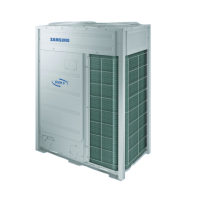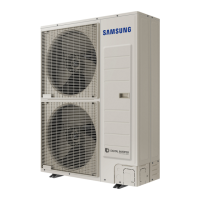Do you have a question about the Samsung DVM S AM220FXVAGH and is the answer not in the manual?
Emphasizes consulting professionals for safe and proper installation to prevent issues.
Stresses the importance of following the installation manual for correct procedures.
Advises managing refrigerant levels in small rooms to meet safety limits.
Warns against using gases or impurities other than R-410A, which can cause malfunction.
Mandates the use of supplied accessories, specified components, and tools for installation.
Requires outdoor unit installation on a stable, load-bearing surface that can support its weight.
Advises removing flammable materials around the work area before welding operations.
Recommends removing refrigerant from pipes before welding to prevent pipe bursting.
Warns against unauthorized modifications to the product to prevent risks.
Stresses the importance of securely fixing outdoor units to withstand strong winds or earthquakes.
Mandates that electrical work must be performed by qualified persons according to regulations.
Emphasizes the necessity of performing correct grounding to prevent electric shock.
Advises secure wiring connections to prevent external force on terminals, avoiding heat generation.
Stresses neat wire arrangement and secure closure of electrical covers to prevent hazards.
Requires installation of an exclusive circuit breaker (MCCB, ELB) for the power supply.
Prohibits the use of damaged parts to prevent fire or electric shock.
Mandates cutting off power before performing installation, maintenance, or repair on electrical parts.
Advises waiting for DC voltage discharge before replacing or repairing PCBs.
Recommends ventilating the room if refrigerant gas leaks during installation.
Requires checking for gas leakage after the installation is completed.
Warns of the risk of frostbite from contact with leaked refrigerant gas.
Advises proper drain pipe installation to prevent freezing or bursting.
Specifies minimum distances for cables from electrical appliances and lightning conductors.
Warns against storing refrigerant containers in direct sunlight due to explosion risk.
Emphasizes using appropriate pipes for high refrigerant pressure.
Advises installing the product out of children's reach to prevent injury.
Prohibits installation in areas with combustible gas or flammable materials.
Stresses the necessity of trial operation via outdoor unit key mode for normal function.
Emphasizes using DVM S compatible indoor units.
Guides on using tables to determine outdoor unit size and quantity for capacity needs.
Advises choosing locations that minimize disturbance from discharge air or noise.
Recommends locations with structural integrity for unit weight and vibration.
Suggests flat, non-water-collecting surfaces for installation.
Emphasizes well-ventilated locations with adequate service access.
Recommends locations for easy waterproofing and drainage of condensation.
Stresses choosing locations free from inflammable gas leakage risks.
Prohibits direct exposure to sea breeze, recommending protective measures.
Advises selecting locations away from sources of electromagnetic interference.
Recommends installing units where heavy snowfall won't obstruct airflow.
Advises installing outdoor units in high locations with safety precautions like fences.
Prohibits installation in areas producing corrosive gases, suggesting protective measures.
Stresses keeping flammable materials away from the outdoor unit to prevent fire spread.
Stresses securing adequate ventilation and service space.
Warns that narrow spaces can lead to installer injury and product problems.
Advises securing sufficient ventilation space when installing multiple outdoor units together.
Warns to remove wooden pallet before installation to prevent fire or damage.
Emphasizes securing outdoor units with anchor bolts on the base.
Specifies base ground height (≥200mm) and drainage pit installation.
Stresses strong base ground and a flat top surface for vibration and noise reduction.
Mandates base ground size to be 1.5 times larger than the outdoor unit bottom.
Requires firm fixation to withstand 30m/s wind speed.
Highlights drainage and waterproofing needs for defrost water in heating mode.
Details installing anti-vibration pads or frames to prevent vibration transfer.
Instructs on fixing the unit to the frame using bolts, nuts, and washers.
Recommends snow prevention ducts to avoid snow accumulation and frost.
Provides calculation factors for additional refrigerant based on liquid pipe size.
Explains removing burrs from cut pipe edges to prevent gas leaks.
Warns about foreign matter removal to prevent gas leaks and damage.
Lists MCA and MFA ratings for circuit breakers and power cables for various models.
Details requirements for connecting to the power supply system and system impedance.
States compliance with IEC standard for short-circuit power.
Warns about installing ELCB/MCCB+ELB, operating without pipes, and cable handling.
Warns about fire risk from exposed core wire due to sheath damage.
Illustrates power wiring for 3-phase 4-wire systems.
Shows power wiring for single-phase 2-wire systems.
Warns against power cable contact with pipes to prevent damage or fire.
States that grounding must be performed by a qualified installer for safety.
Guides grounding the power cable based on installation place and voltage.
Details requirements for grounding work 3, including resistance checks.
Details using nitrogen gas for air tightness testing.
Guides on applying pressure and checking for gas leaks.
Provides cautions regarding nitrogen gas leak tests and pressure regulators.
Explains using vacuum pumps with check valves and closing service valves.
States R410A is blended refrigerant and advises liquid charging by scale.
Provides information on regulations for fluorinated greenhouse gases (tCO2e).
Warns against leakage during installation and refrigerant collection.
Covers pipe length, height difference, pressure, and pipe cleanliness.
Lists additional refrigerant amounts for various indoor unit models and capacities.
Explains how to calculate total additional refrigerant (pipe length + indoor unit).
Provides important safety information for refrigerant pipe welding.
Details the process of connecting flared pipes.
Mandates using ester oil to coat flare connection sections.
Provides cautions regarding nitrogen gas, flare nuts, bending pipes, and excessive tightening.
Warns about heat damage during welding and protecting sensors and service valves.
Recommends Y-joints over T-joints for optimal refrigerant distribution.
Shows H/P installation diagrams and pipe length allowances.
Details pipe length limits for outdoor-to-indoor and outdoor-to-outdoor connections.
Details length limits for branch joints to indoor units and total extended pipe length.
Shows H/R installation diagrams and pipe length allowances with Y-joints.
Details pipe length limits for H/R systems based on configuration.
Specifies maximum allowable height differences for H/R systems.
Details length limits after branch joints for H/R systems.
Describes possible results (Setting completed, Setting error) and error codes.
Details checks for insulation resistance, voltage, and phase before power supply.
Covers checks for pipes, valves, unit quantity, length, joints, insulation, and refrigerant quantity.
Warns about warm-up time, touching pipes, panel removal, and power off timing.
Lists checks for cables, pre-heating, voltage/phase, unit tracking, and reports.
Advises checking error codes (E503, E505, E506) and taking measures.
Provides a flowchart for troubleshooting E503 errors.
Provides a flowchart for troubleshooting E505 and E506 errors.
Warns to cut off power before component replacement or inspection.
| Brand | Samsung |
|---|---|
| Model | DVM S AM220FXVAGH |
| Category | Air Conditioner |
| Language | English |











